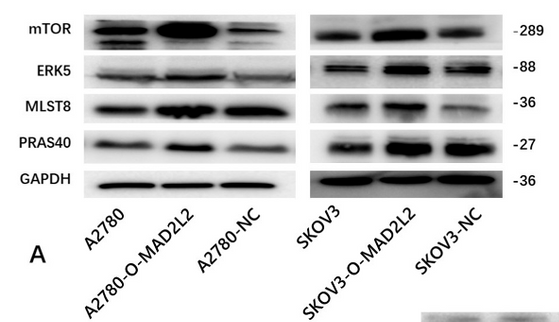PRAS40 Antibody - #DF8396
| Product: | PRAS40 Antibody |
| Catalog: | DF8396 |
| Description: | Rabbit polyclonal antibody to PRAS40 |
| Application: | WB IF/ICC |
| Cited expt.: | WB |
| Reactivity: | Human |
| Prediction: | Pig, Bovine, Horse, Sheep, Dog |
| Mol.Wt.: | 27 kDa; 27kD(Calculated). |
| Uniprot: | Q96B36 |
| RRID: | AB_2841651 |
Product Info
*The optimal dilutions should be determined by the end user. For optimal experimental results, antibody reuse is not recommended.
*Tips:
WB: For western blot detection of denatured protein samples. IHC: For immunohistochemical detection of paraffin sections (IHC-p) or frozen sections (IHC-f) of tissue samples. IF/ICC: For immunofluorescence detection of cell samples. ELISA(peptide): For ELISA detection of antigenic peptide.
Cite Format: Affinity Biosciences Cat# DF8396, RRID:AB_2841651.
Fold/Unfold
40 kDa proline rich AKT substrate; 40 kDa proline-rich AKT substrate; AKT1 S1; AKT1 substrate 1 (proline rich); AKT1 substrate 1; AKT1S 1; AKT1S1; AKTS1_HUMAN; Lobe; MGC2865; PRAS 40; PRAS; PRAS40; Proline rich akt substrate; Proline rich Akt substrate 40 kDa; Proline-rich AKT1 substrate 1;
Immunogens
A synthesized peptide derived from human PRAS40, corresponding to a region within the internal amino acids.
Widely expressed with highest levels of expression in liver and heart. Expressed at higher levels in cancer cell lines (e.g. A-549 and HeLa) than in normal cell lines (e.g. HEK293).
- Q96B36 AKTS1_HUMAN:
- Protein BLAST With
- NCBI/
- ExPASy/
- Uniprot
MASGRPEELWEAVVGAAERFRARTGTELVLLTAAPPPPPRPGPCAYAAHGRGALAEAARRCLHDIALAHRAATAARPPAPPPAPQPPSPTPSPPRPTLAREDNEEDEDEPTETETSGEQLGISDNGGLFVMDEDATLQDLPPFCESDPESTDDGSLSEETPAGPPTCSVPPASALPTQQYAKSLPVSVPVWGFKEKRTEARSSDEENGPPSSPDLDRIAASMRALVLREAEDTQVFGDLPRPRLNTSDFQKLKRKY
Predictions
Score>80(red) has high confidence and is suggested to be used for WB detection. *The prediction model is mainly based on the alignment of immunogen sequences, the results are for reference only, not as the basis of quality assurance.
High(score>80) Medium(80>score>50) Low(score<50) No confidence
Research Backgrounds
Subunit of mTORC1, which regulates cell growth and survival in response to nutrient and hormonal signals. mTORC1 is activated in response to growth factors or amino acids. Growth factor-stimulated mTORC1 activation involves a AKT1-mediated phosphorylation of TSC1-TSC2, which leads to the activation of the RHEB GTPase that potently activates the protein kinase activity of mTORC1. Amino acid-signaling to mTORC1 requires its relocalization to the lysosomes mediated by the Ragulator complex and the Rag GTPases. Activated mTORC1 up-regulates protein synthesis by phosphorylating key regulators of mRNA translation and ribosome synthesis. mTORC1 phosphorylates EIF4EBP1 and releases it from inhibiting the elongation initiation factor 4E (eiF4E). mTORC1 phosphorylates and activates S6K1 at 'Thr-389', which then promotes protein synthesis by phosphorylating PDCD4 and targeting it for degradation. Within mTORC1, AKT1S1 negatively regulates mTOR activity in a manner that is dependent on its phosphorylation state and binding to 14-3-3 proteins. Inhibits RHEB-GTP-dependent mTORC1 activation. Substrate for AKT1 phosphorylation, but can also be activated by AKT1-independent mechanisms. May also play a role in nerve growth factor-mediated neuroprotection.
Phosphorylated by AKT1. Phosphorylation at Thr-246 by DYRK3 relieves inhibitory function on mTORC1.
Cytoplasm>Cytosol.
Note: Found in the cytosolic fraction of the brain.
Widely expressed with highest levels of expression in liver and heart. Expressed at higher levels in cancer cell lines (e.g. A-549 and HeLa) than in normal cell lines (e.g. HEK293).
Research Fields
· Cellular Processes > Transport and catabolism > Autophagy - animal. (View pathway)
· Environmental Information Processing > Signal transduction > mTOR signaling pathway. (View pathway)
· Environmental Information Processing > Signal transduction > AMPK signaling pathway. (View pathway)
· Organismal Systems > Aging > Longevity regulating pathway. (View pathway)
· Organismal Systems > Aging > Longevity regulating pathway - multiple species. (View pathway)
References
Application: WB Species: Human Sample:
Restrictive clause
Affinity Biosciences tests all products strictly. Citations are provided as a resource for additional applications that have not been validated by Affinity Biosciences. Please choose the appropriate format for each application and consult Materials and Methods sections for additional details about the use of any product in these publications.
For Research Use Only.
Not for use in diagnostic or therapeutic procedures. Not for resale. Not for distribution without written consent. Affinity Biosciences will not be held responsible for patent infringement or other violations that may occur with the use of our products. Affinity Biosciences, Affinity Biosciences Logo and all other trademarks are the property of Affinity Biosciences LTD.
